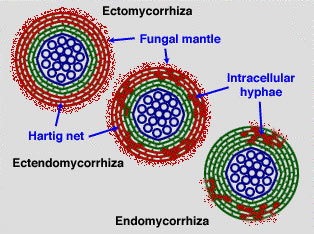Specialised Roots: Mycorrhizal Types
Mycorrhizae can be grouped into three main morphological categories: ecto-, endo- and ectendo- mycorrhizae.
Look at the diagram of root cross sections...
Ectomycorrhizae form a hyphal sheath or mantle around the root with a network of hyphae (called the Hartig net)
between the cortical cells. The fungus does not penetrate the host's cell walls.
Endomycorrhizae do not form a mantle (the hyphae tend to only loosely cover the root and grow out into the surrounding soil).
Instead, the area of contact between the root and the fungus is increased by hyphae penetrating the cortical cell walls
(but not the cell membrane).
Ectendomycorrhizae possess features of the two previous types. They form both a mantle and penetrate the cortical cell walls.

Diagramatic representation of cross sections of the three main types of mycorrhizal roots. 'Cells' with red outlines represent the intercellular hyphae, which make up the Hartig net; those with red contents represent intracellular hyphae; and those with green outlines represent normal root cortical tissue. The blue tissue is the vascular tissue.
